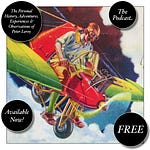I GOT THE JOB advertised on the back of the clipping that Robert sent me, and for the last nine years I have been the only Roger Drake. Since the series had become dated in its topical references and in the props that the succession of earlier Roger Drakes had used, my first task was to revise all the earlier books, in sequence. Thereby, of course, I got the opportunity to bring the books more in line with what I had imagined them to be, and even to insert here and there some of the episodes that I had imagined occurring in the gaps between adventures. I have also written eight adventures that are entirely my own, and the income from the Larry Peters books that I’ve written, added to what we make from the hotel (which is small for the effort involved) has allowed Al and me to live quite comfortably for the last five years or so, or at least would allow us to live quite comfortably if we had any sense about money at all.
I am often asked whether the Larry Peters books that I have written are autobiographical. They are and they are not. It’s not surprising, I suppose, that the characters in my version of Larry Peters have acquired some of the habits, expressions, and physical characteristics of people that I have actually known. Larry’s friend Rocky King has become more and more like my friend Raskol. Lucinda and Marie exhibit aspects of most of the girls and women I ever had any interest in. Larry’s father and mother seem to be composed of equal parts derived from the depictions of them in the earlier Larry Peters books, my own parents, and both sets of my grandparents. I have also included details and props from my life in Larry’s: the kittens that live beneath the Peterses’ front porch are the very kittens I pursued on my grandparents’ lawn the day that Mr. Beaker introduced Eliza Foote to us, the day that my mother fell out of her lawn chair. The alabaster busts of Peterses that reside in lighted niches in the wall along the staircase are derived from the coconuts my great-grandmother carved to represent Leroys. In that capacious summer during which all the adventures occur, there is room for everything, and nothing changes much once it has been admitted into Larry’s world. So, at the top of the Peterses’ house, my great-grandmother lives forever, unchanging, still strong, playing the part of the matriarch of the Peters bunch, offering the guidance that so often holds the key to the solution of the mystery in each book.
The publisher has complained from time to time that the changes I have made in the series have led to the misperception of the books as being intended for adult readers, rather than for adolescents, and that the “adventures” I write for Larry are not really adventures. Well, I never thought that the Larry Peters books were intended only for adolescents, and I never thought that the adventures were very important. I try, I do try, to include in each episode something that will build suspense, but I find that as I work on, say, the stealthy approach of saboteurs who are bent on destroying the prototypes for next year’s line of Peters knickknacks, my attention is easily diverted to, for example, Larry and Lucinda, who are having an interesting conversation about love and jealousy while they sit on the lowest limb of the apple tree out beyond the gazebo. Larry’s adventures are more likely to be little adventures of his growing-up, which turn out to resemble the little adventures of my own.
Making everything snap together at the end is what makes the writing of each Larry Peters book an adventure for me; it provides the small part of writing them that is play. I’ve tried, most of the time, to make an object or an idea control the book, like a cotter pin, say, that appears and reappears unexpectedly—at the bottom of a drawer, in someone’s pocket, hanging improbably on a gold chain—and snapping into place at the end as the pin that holds the whole gadget together. Not everyone likes that sort of thing, of course, and many of my readers have written quite persuasive letters asking for fewer cotter pins and more laughs.
In Topical Guide 206, Mark Dorset considers Autobiography and Fiction; Reality: Real and Fictional; and Form and Content from this episode.
Have you missed an episode or two or several?
You can begin reading at the beginning or you can catch up by visiting the archive or consulting the index to the Topical Guide.
You can listen to the episodes on the Personal History podcast. Begin at the beginning or scroll through the episodes to find what you’ve missed.
You can ensure that you never miss a future issue by getting a free subscription. (You can help support the work by choosing a paid subscription instead.)
At Apple Books you can download free eBooks of “My Mother Takes a Tumble,” “Do Clams Bite?,” “Life on the Bolotomy,” “The Static of the Spheres,” “The Fox and the Clam,” “The Girl with the White Fur Muff,” “Take the Long Way Home,” “Call Me Larry,” and “The Young Tars,” the nine novellas in Little Follies, and Little Follies itself, which will give you all the novellas in one handy package.
You’ll find an overview of the entire work in An Introduction to The Personal History, Adventures, Experiences & Observations of Peter Leroy. It’s a pdf document.















Share this post